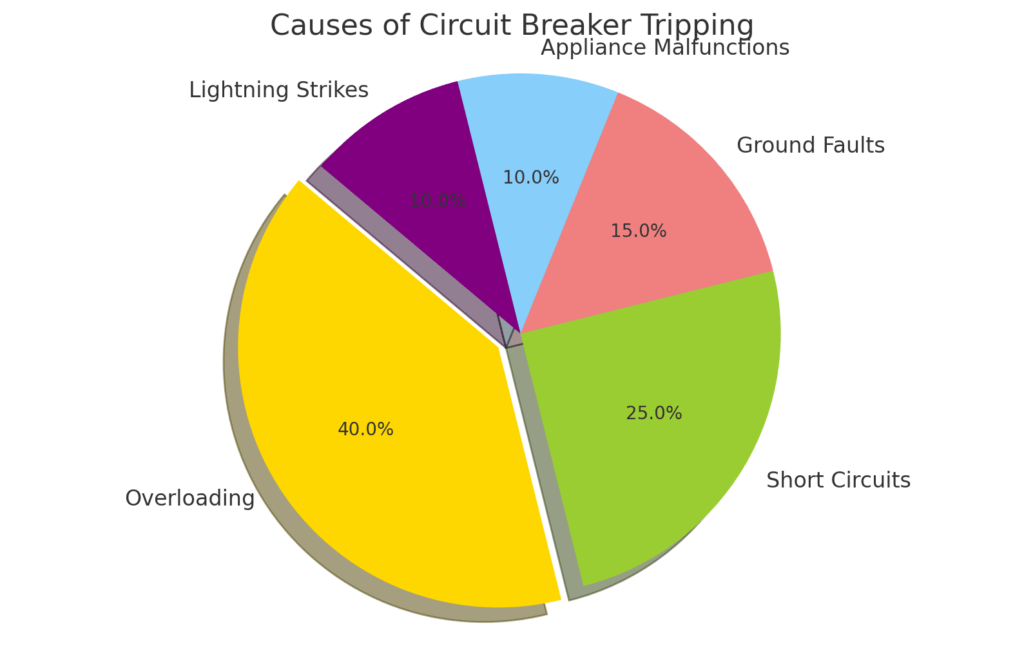5 MAIN REASONS WHY YOUR CIRCUIT BREAKER KEEPS TRIPPING
Repeated circuit breaker trips are commonly caused by overloading circuits, short circuits, ground faults, appliance malfunctions, or electrical surges from lightning strikes and storms.
Overloading Circuits: This happens when the collective draw of all devices and appliances on a single circuit exceeds the safe threshold, leading to overheating wires and components.
Short Circuits: Occur when electricity flows through an unintended path with very low resistance, usually due to a fault in insulation or damaged wires touching, drawing excessive amperage from the supply.
Ground Faults: These happen when electricity escapes its intended path and flows into the grounding system, which can pose a potentially lethal shock hazard.
Appliance Malfunctions: Faulty appliances with compromised electrical insulation can draw excess current and trigger overloads or short circuits.
Lightning Strikes and Storms: Sudden spikes in electrical current from storms and lightning strikes can cause surges that trip breakers.
Understanding the Common Causes of Circuit Breaker Tripping
Circuit breakers are an essential safety feature in any home’s electrical system, designed to protect your home against electrical fires and shock hazards. By automatically cutting off power when electrical circuits get overloaded, shorted, or experience other faults, circuit breakers prevent further damage and help minimize risks.
However, having your circuit breakers randomly trip can also lead to sudden power loss and electrical shutdowns for appliances, lights or outlets in parts of your home. Identifying the reasons why your circuit breaker keeps tripping is key to finding solutions and restoring uninterrupted power supply.
In this comprehensive guide, we’ll walk through the most common causes of nuisance circuit breaker tripping, tips to troubleshoot the issues, and when it’s safest to call a professional electrician.

Overloading Circuits
One of the most common triggers for circuit breakers tripping is overloading a circuit. Electrical circuits have a defined amperage limit or load capacity. When the collective draw of all devices and appliances on a single circuit exceeds this safe threshold, it will trip the circuit breaker to avoid overheating wires and components.
Some ways overloading circuits happen include:
Adding major new appliances like air conditioners or electric heaters to a circuit at its capacity. Their high power draw can overload the circuit.
Plugging in too many small appliances like hair dryers, microwaves, or vacuum cleaners on the same circuit. Their combined load can overload it.
Operating high-wattage appliances like stoves, dryers or HVAC systems at the same time on a shared circuit.
Drawing excess current due to faulty wiring. For example, neutral and ground wires touching can double the amperage.
Extension cords and power strips connected to outlets can increase loads beyond safe limits if used improperly.
Operating motors or compressors with high startup current exceeding a circuit’s capacity.
When circuits get overloaded, heat builds up in the wires which can lead to insulation melting, fires, and excessive voltage drops. Circuit breakers are designed to trip before this happens, cutting power to the circuit.
If you suspect overloads when your circuit breaker trips, unplug all non-essential devices and see if it holds. Try moving high-draw appliances like freezers to another circuit as well. Calling an electrician is recommended to check if wiring improvements and added circuits are needed to support your home’s power needs.
Short Circuits
Short circuits occur when electricity flows through an unintended path with very low resistance, usually due to a fault in insulation or damaged wires touching. Instead of following the normal path through appliances, a short circuit allows current to bypass them while drawing excessive amperage from the supply.
Signs of a short circuit include:
Circuit breaker immediately trips when reset
Fuses blowing or burning smell from outlets
Flickering or dimming lights
Warm or charred outlet plates or switch covers
Buzzing, sizzling or humming from outlets
Short circuits are extremely dangerous because of heat buildup and exposed live wires. The risks include electrical fires, shock hazards, and damage to connected appliances. Circuit breakers are designed to quickly cut off power in milliseconds if a short is detected.
If you suspect a short, switch off the main breaker immediately and call an electrician. Never reset the breaker until the short is identified and resolved, as it can re-trip and worsen damage each time. The repairs required depend on the fault – from resetting loose wires to replacing damaged cables or devices.

Need an Electrician?
BOOK ONLINE TODAY
Ground Faults
A ground fault occurs when electricity escapes its intended path and flows into the grounding system. While not as dangerous as a short circuit, it can still pose a potentially lethal shock hazard.
Ground faults happen due to damaged insulation and exposed conductors touching the ground. Causes include:
Frayed or cracked insulation on wires
Faulty devices leaking current
Overloaded neutral wires
Moisture entering cables or devices
When a ground fault is detected, the circuit breaker immediately trips. Unlike overloads and shorts, you may not observe any visible signs or symptoms with ground faults.
Resetting the breaker will likely trip it again until the ground fault is repaired. If the breaker keeps tripping with no obvious cause, it is safest to call an electrician immediately for diagnosis. They can locate the fault using clamp meters and insulation testing and suggest the repairs needed, like replacing old wires or water-damaged devices.

Appliance Malfunctions
Faulty appliances with compromised electrical insulation can also lead to nuisance circuit breaker tripping in homes. As appliances age and components start failing, they can draw excess current and trigger overloads.
Warning signs of an appliance causing tripped breakers include:
Breaker trips only when the appliance is switched on
Unusually frequent tripping of a circuit breaker
Appliance shows other electrical issues like sparks, shocks or overheating
Appliance motors sound strained and sluggish
Some common appliance faults that lead to breaker trips:
Compressor issues in refrigerators, freezers, and HVAC systems.
Shorted or worn motor windings in vacuum cleaners, blenders etc.
Heating element failure in ovens, dryers and water heaters
Shorted internal wiring and circuits
Insulation breakdown
If an appliance seems problematic, disconnect it and see if the tripping stops. Older large appliances like AC units and freezers that exceed modern energy standards are more prone to cause overloads. Replacing them with new ENERGY STAR models can help if they are over 10-15 years old.
Need an Electrician?
BOOK ONLINE TODAY
Lightning Strikes and Storms
Storms and lightning strikes nearby can cause sudden spikes in electrical current leading to surges. While homes have surge protectors, a very close or direct lightning hit on or near your building can trip breakers.
Lightning can induce current surges by:
Striking nearby power lines causing electrical spikes
Surges through ground wires and plumbing
Damaging wiring insulation and triggering short circuits
You may observe flickering lights, buzzing speakers, or tripped surge protectors during storms along with breakers tripping. But after the storm passes, if the breakers reset normally power was likely just temporarily disrupted.
However, a close or direct lightning strike can overload and permanently damage electrical systems. Signs of a lightning-caused electrical issue include:
Burn marks or melted insulation on outside electrical wiring
Strong burning smell from outlets
Blackened or cracked surge protectors
Equipment like computers and appliances suffering damage
Breakers immediately re-tripping or not resetting at all
In such cases, safety risks are involved. Calling an electrician for inspection and repairs is highly recommended.

Conclusion
Circuit breakers are vital protective devices, and occasional tripping due to overloads is normal. But repeated, unexplained breaker trips or tripping at odd times indicates an underlying electrical issue.
Diagnosing and addressing the root causes early is important to avoid greater risks and prevent damage. If the reasons are unclear, it’s always safest to call a licensed electrician to inspect and make the needed repairs. Prioritize electrical safety, and avoid attempting DIY repairs on your home’s wiring.
Need an Electrician?
BOOK ONLINE TODAY
We have over 10 years’ experience in the industry, delivering comprehensive electrical services




